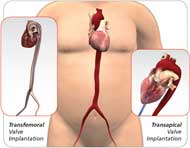
Treatment Options
Treatment Options
Replacement of the aortic valve is typically done in a surgical procedure, and depending on your condition and your doctor’s assessment, a transcatheter valve replacement may be selected.
Surgical Valve Replacement

Surgical valve being sewn into place
Surgical aortic valve replacement, or SAVR, is done through an open-heart procedure; the chest is opened up so the surgeon can access the heart and the patient is placed on cardiopulmonary bypass.
During surgical valve replacement, the surgeon removes the narrowed valve and replaces it with either a mechanical valve (metal) or a biological valve (constructed of animal or human tissue). Different valve types have different benefits and risks. You and your doctor will choose a valve best suited to you based on your individual lifestyle, age and medical condition.
Benefits of SAVR Each year, more than 250,000 heart valve surgeries take place across the world. Surgical valve replacement has been performed for many years and has consistently produced excellent results in lengthening patients’ lives and improving their quality of life.
Transcatheter Valve Implantation

Valve delivery via catheter and balloon inflation
Transcatheter aortic valve implantation, or TAVI, enables replacement of the aortic valve without opening the chest. This less invasive procedure is now available for patients considered to be at high-risk for open-heart surgery. In the TAVI procedure, the valve is squeezed down onto a balloon, inserted into the body via a catheter (a long flexible tube), and tracked to the heart for implantation. This can be done without opening the chest or using the heart-lung pump. The catheter may be inserted through the femoral artery (in the groin) or through a small incision in the chest over the heart. When the valve is positioned inside the faulty aortic valve, the balloon is inflated and the valve is precisely positioned.
Benefits of TAVI include a shorter procedure, less pain, and a shorter stay in the hospital. Because it is non-invasive, recovery time is significantly shorter than after open-heart surgery – about 2 to 4 weeks instead of 6 to 8 weeks. As with surgical heart valve replacement, TAVI provides both short- and long-term relief of symptoms, normal aortic valve function and improvement in your overall life expectancy and functioning.
Risks
Potential risks of valve replacement vary significantly from person to person depending on age, overall health, and other factors. Your doctor will discuss the risks in detail before you consent to the procedure. Your doctor will further evaluate your condition and determine if you should be referred to a heart team. His analysis will include a comprehensive physical examination plus evaluating the results of a number of blood tests and imaging studies which may include an ECG, an echocardiogram, a coronary angiogram, and/or other tests. It is important to note, however, that untreated severe aortic stenosis poses a high risk of progressive symptoms or death.